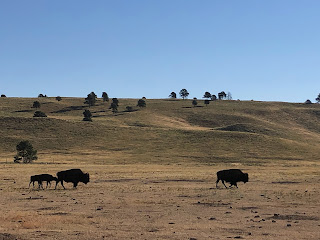Custer Morning ... and More Bison!
CUSTER STATE PARK entrances us both. Its rolling hills, yellow grasses, varied pine trees and open lands surprise and engage us both. We stop so that I can make this painting, not of sunflowers or big skies, but of this land, this huge and beautiful land of ours, that pulls at my eyes and my heart.
This is not one of the $100 paintings, but is available. Your sponsorship payment can of course go toward the cost of this painting. I am going to post it on Facebook and on my website, and make it available, so if you are a sponsor and you do want it, please let me know sooner rather than later.
***
WE SPEND THREE DAYS in Custer State Park. Its 71,000 acres contain bison, antelope, burros and prairie dogs. These creatures are a riot! And am glad we don't have them in Virginia, as I bet they'd destroy every garden around. My laughter at them would surely turn to tears and swearing.
We are told the park contains mountain sheep and mountain goats, and we search and search for them, but alas, see none.
Also, there are not many birds! We see a few bluebirds, a couple rose-breasted grosbeaks, an osprey and some gray birds that I can't identify - but that's it.
After seeing the bison herd in the evening, we decide to go back in the morning and see if we can find them there early.
And find them, we do - three separate herds, coming down hills to the north and the south, and crossing the plain near the road, walking with purpose toward the Bison Center, an educational center and gift shop with barns and corrals.
We figure they are going there for breakfast or maybe water or both at the center - but we are wrong.
Workers at the center tell us that the park does not give the bison any food or water. The herds are simply grazing, heading toward a pasture that looks good this morning. They follow the lead female - and right now, with the herd split into pieces, a couple females are vying for dominance. The females choose different grazing areas every day, and the herds follow.
There are more than 1,300 bison in Custer. Every year, there is a roundup, where the herd is culled, brought down to a number that the vegetation in the park can sustain.
The roundup starts gently and slowly, right about now, when workers begin moving fences in the park to guide the herds into smaller and smaller areas.
Even before the roundup, females cut the big males out. Then they are left outside the fence, as they are too ornery and strong. We see three of them there on the morning we leave Custer. They are grazing more or less together in a beautiful area with abundant grass, and while I feel a little bad for them, they are probably not lonely, and they certainly look strong and healthy.
When the bison are rounded up, they are vaccinated, branded and tagged. The females are checked for pregnancy.
Then 200 or more, or as many as the park estimates need to goAugust , are sold at auction. The separation system that works on guidelines including gender, size, strength and age.
The roundup is apparently quite a spectacle and draws a huge crowd. At first, I think this would be something grand to watch, but I see a video of it and decide that, in fact, I wouldn't like it. I understand that it is vital for the herd and for the park, and I know the bison are treated well and humanely during it, but I think they must be terrified - and I know I wouldn't want to see that, or hear it, or feel it in my heart and soul.
The bison that are culled are sold at an auction in November. Some go to herds near and far, and others are sold for meat.
As we watch the bison, early in the morning, in the quiet of the park, with the cool day beginning to burn August hot, warming the yellow prairie grass, we shut off the car and watch in silence, and it is like it must have been, centuries ago, when these huge animals - as many as 60 million of them - lived in vast herds ranging across the US and Canada, pretty much everywhere but the coasts.
They walk on surprisingly slender legs, their ankles bending elegantly with each step. They place each hoof carefully. They eat pretty much constantly, even while walking, and their huge heads are set low, low, low on their bodies, and bob up and down with each step, massive shoulders chugging with the load, the movement.
Their hindquarters are surprisingly narrow, but heavily muscled. They do not go downhill well, stumbling and sliding as they make their way. But when they run, they run fast, loping, front legs bending and catching the earth, back legs pushing off, propelling them along. And sometimes, they leap and kick up with those slender back legs. In the youngsters, this looks like playing. In the older bison, it looks like a response to an irritating situation.
The day we leave the park, I feel a surprising loss that we will not see the bison for another morning.

















Comments
Post a Comment